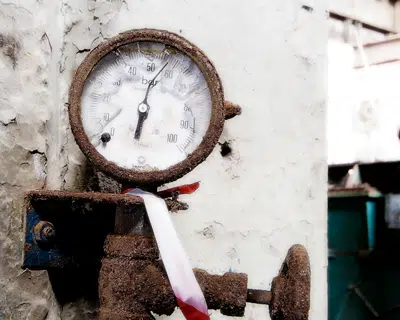
Problems arise when these conditions are mismanaged. The scary part is, mismanagement happens regularly – all the time, in fact. Pressure gauges play a critical role in monitoring the handling and flow of liquids. One major pressure gauge manufacturer suggests that 25 percent of pressure gauges in a typical plant need replacement or repair.
The exact words of the senior instrumentation engineer are telling:
“There is very little scheduled maintenance for gauges. Sometimes someone is walking around and sees a problem, but that's about it. We found that about 25 percent of gauges in plants are about to fail, are unreadable, or the case has broken off. That's from looking at 250 plants and more than 150,000 installations of gauges.”1
This statement coincides with those of Larry Bachus, our favorite pump expert, who asserts:
“As a pump consultant, I see too many pumps without gauges. I see gauges where the needle has fallen off the stem.”
“I see gauges where the cover glass is fogged ... or broken. All pumps should have suction and discharge pressure gauges installed. The gauges should be calibrated, clean, and adequate for the service.”2
Clearly, pressure gauge maintenance is going the way of the buffalo. Part of the problem is training, another part is workload, and another part of the problem is technology. Let’s take a look at all three.
Forgotten Training
Do you really know how to use a pressure gauge? Do you know how to take a pressure reading and turn it into useful, actionable information? How many of your gauges are in disrepair, and how many of those are ever actively monitored?
It’s becoming clear that we are forgetting how to use a pressure gauge to keep our liquid handling equipment in top shape. I have personally spoken with several veteran process and instrumentation engineers that have decided to remove pressure gauges from their equipment. They keep a handful of calibrated gauges in their drawer and pull them out when they suspect an issue. They do this because they know the gauges will end up broken if left on the equipment, and they don’t want to maintain that many gauges.
I wonder how much they’re missing by not constantly monitoring their pumps, pipes, and fittings.
Pressure gauges are more than just an early warning system, or a canary in a coal mine. They should typically be used in pairs, to read a differential pressure across a filter, valve, length of pipe, or pump. They tell us how things are flowing, if there is a restriction in the line, and if pressure is building up anywhere. If used right, they help us actively prevent leaks, ruptures, spikes, and equipment failure in real time.
They should be more of a bloodhound than a canary.
You get out of them what you put in to them. Take the time to learn how gauges can benefit your process, and then train your people to do it right.
Work Overload
Once you figure out how gauges should be used, you have to figure out how you’re going to do it with limited resources.
Taking manual readings from thousands of gauges in your plant is not easy. You need a small army performing routine walks to take pressure readings and translate those into equipment reliability.
Unfortunately, if you’re like most of us, your workforce is limited, and everyone has more responsibility, more workload. How can you add yet another thing to do without hiring someone to do it? If you’re using analog pressure gauges and you can’t keep up with all of them, then training isn’t your only problem.
The only way to fix this problem is with better technology.
Using Better Technology
Analog (dial) pressure gauges have served industry well for a long time now. But they require constant manual monitoring. And a lot of them are tough to get to. Ready for a long walk, some ducking, climbing, and squeezing? I hope so.
The truth is, manual monitoring is hard, it’s time consuming, and it’s completely unnecessary.
Here’s where technology comes to the rescue. These days we have digital pressure gauges. They make pressure monitoring much easier in many ways:
The point is you can make it easier on yourself if you invest in digital pressure gauges for your plant. They’re easier to use than dial gauges, making the training process easier, and they don’t require manual monitoring.
Achieving Safety And Reliability
Your two goals are 1) safety, and 2) equipment reliability.
A faulty pressure gauge is a serious safety risk. In Carl Safina’s book about BP’s Deepwater Horizon disaster in the Gulf of Mexico, we find an excellent but tragic example of pressure gauges and safety.
The author notes that two different pressure gauges were telling two different stories. One showed pressure building up, while the other looked normal. The technicians decided to trust the gauge that looked normal. Unfortunately, that was the faulty gauge.1
We make misinformed decisions about our process equipment everyday when we don’t pay attention to our gauges, or when we allow them to fall into disrepair. Eventually, one of those decisions will have dire consequences.
Avoid disaster by using reliable, digital pressure gauges. They’re more durable, more accurate, and easier to monitor effectively. You’ll keep your equipment running properly and avoid excessive maintenance, and you’ll keep your co-workers safe.
Let us know how we can help you with your pressure gauges. There are a lot of options out there, but we feel like we have product of superior quality and with the right options.
top photo credit: Timm Suess via photopin cc
Sources:
1) https://www.designnews.com/automation-motion-control/broken-gauge-could-blow-plant/13909163030860
2) https://www.piprocessinstrumentation.com/home/article/15554231/go-cook-a-pizza